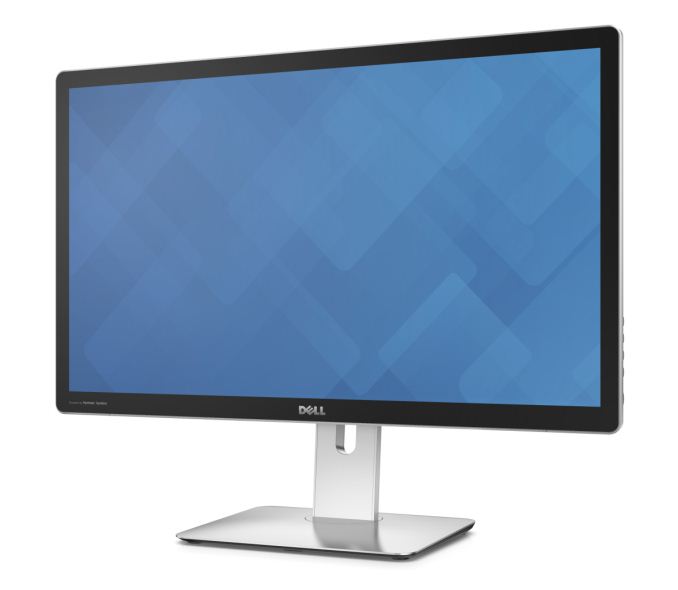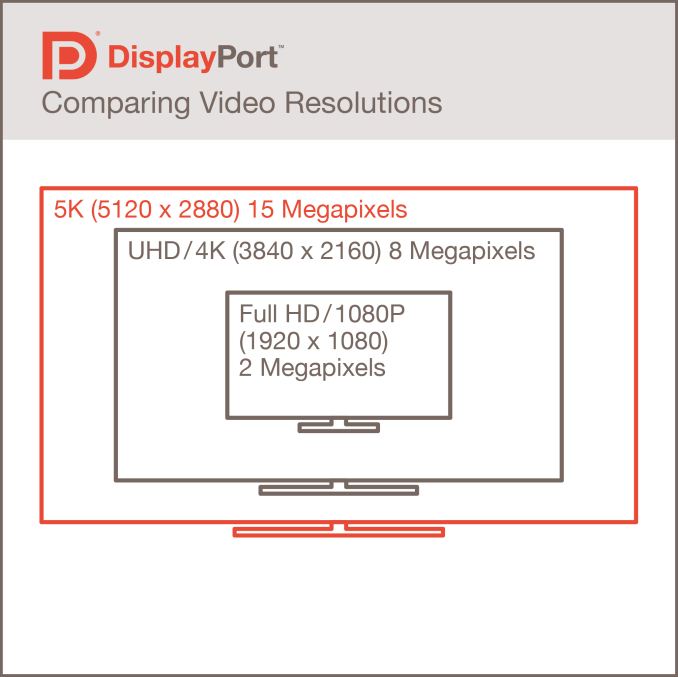VESA Releases DisplayPort 1.3 Standard: 50% More Bandwidth, New Features
by Ryan Smith on September 16, 2014 8:00 AM EST- Posted in
- Monitors
- Displays
- DisplayPort
- VESA

Although DisplayPort-equipped 4K monitors are still relatively new, the DisplayPort 1.2 standard underlying those devices is anything but. The long lead time between standards and products means that just as 4K monitors turn a year old, the DisplayPort 1.2 standard driving them will turn 5 years old later this year. This gap means that the VESA working group responsible for DisplayPort needs to aim well ahead of the curve, and all the while DisplayPort 1.2 adoption was ramping up, the VESA was already working on the next iteration of DisplayPort. Now after about 2 years of development the VESA has finalized their next standard, and this week they are releasing the DisplayPort 1.3 standard to their members for inclusion in their next-generation products.
Like DisplayPort 1.2 before it, DisplayPort 1.3 is a combination signaling and feature update intended to support new products and ultimately enable DisplayPort to push more pixels. The single biggest aspect of this is the introduction of High Bit Rate 3 (HBR3) mode, which increases the per-lane bandwidth rate from 5.4Gbps to 8.1Gbps, allowing for a 50% increase in bandwidth over DisplayPort 1.2’s HBR2. For a full 4 lane DP connection, this means the total connection bandwidth has been increased from 21.4Gbps to 32.4 Gbps, for a final data rate of 25.9Gbps after taking encoding overhead into account.
| DisplayPort Supported Resolutions | |||||||||||
| Standard |
Max Resolution (RGB, 60Hz) |
Max Resolution (4:2:0, 60Hz) |
|||||||||
| DisplayPort 1.1 (HBR1) | 2560x1600 | N/A | |||||||||
| DisplayPort 1.2 (HBR2) | 3840x2160 | N/A | |||||||||
| DisplayPort 1.3 (HBR3) | 5120x2880 | 7680x4320 | |||||||||
At a hardware level the introduction of HBR3 is being made entirely at the controller level, with new controllers utilizing HBR3 signaling over existing hardware. The DisplayPort/mDP connector itself and the physical cabling remains unchanged, meaning HBR3 is fully backwards compatible with existing cabling and should work on any DP 1.1a/1.2 cable that’s built to spec. Built to spec being a key phrase in this case, as in practice HBR3’s higher clock rate will likely expose inferior cables, similar to what happened with the HBR2 earlier this decade.
By incrementally improving DisplayPort’s available bandwidth in this manner the VESA is looking to bring about support for the generation of monitors beyond today’s 4K monitors that DP 1.2 was designed for. This includes both 5K displays – such as the recently announced Dell 5K UltraSharp – and even farther in the future 8K displays.
For 5K displays DisplayPort’s 32.4Gbps provides enough bandwidth to cover a single 5K@60Hz monitor with traditional 24bit uncompressed color. In that case the physical interface can support either SST or MST operation – DisplayPort is merely a data transport layer – however we may still see MST operation used by 5K monitors due to the fact that 5K would require a pixel clock in excess of 1GHz, which will take time for GPUs and display controllers to catch up with.
Meanwhile the 50% increase in bandwidth also offers just enough of an improvement that DisplayPort 1.3 can even drive a pair of uncompressed 4K@60Hz monitors over a single connection, so long as VESA reduced blanking timings are used to minimize the signaling overhead. In that case you can technically even get a 4K@60Hz monitor over a 2 lane connection if desired, which would be useful for any situations where DisplayPort lanes are being taken for other uses (e.g. DockPort). Alternatively the additional bandwidth can be used to drive a single 4K@60Hz monitor at higher bit depths, such as 30bit and 36bit color.
However for 8K displays, while DisplayPort 1.3 is designed to support them the available bandwidth falls well short of the 45Gbps+ an 8K@60Hz 24bit uncompressed display would require. As such the VESA will be doing the next best thing and supporting Y'CbCr 4:2:0 subsampling, which reduces the bandwidth requirements by only transmitting ¼ of the color (chroma) data.
We’ve already seen 4:2:0 put to use in HDMI, allowing first-generation 4K TVs to support 4K@60Hz over HDMI 1.4 data rates by reducing the color data rate to the same 4:2:0 rate that most media is distributed in, and the idea would be the same for DisplayPort 1.3 and 8K displays. 4:2:0 support in this case is a consumer electronics focused feature and is meant to drive high resolution displays handling video and other content mastered at 4:2:0, whereas lower resolution uncompressed modes would still be preferred for workstations and general computer displays.

Wikipedia: diagram on chroma subsampling
4:2:0 support is also necessary for better HDMI interoperability, which is the other major aspect to DisplayPort 1.3. 1.3 will introduce the features necessary to allow DP-to-HDMI 2.0 conversion, and among HDMI-centric additions will be support for HDCP 2.2, which is the minimum version of HDCP required for DRM’d 4K media. Also being added for HDMI interoperability is Consumer Electronics Control (CEC) functionality, which allows HDMI devices to issue commands to other HDMI devices. This will allow DisplayPort to participate in that ecosystem, particularly having DisplayPort devices issue commands to other HDMI devices.
Finally there are a couple of features in development at the VESA that are notably absent in some form or another. Support for Display Stream Compression (DSC) apparently did not make the cut, as it is not in the 1.3 specification. DSC is the VESA and MIPI’s visually lossless (i.e. limited lossy) compression format designed to reduce bandwidth requirements, and based on the VESA’s work we expect it’s still under development and would be surprised if we didn’t see it later on. Meanwhile to no surprise (but always good for clarification), DisplayPort Active-Sync remains an optional part of the specification, so Adaptive-Sync availability will continue to be on a monitor-by-monitor basis as a premium feature.

Not In DP 1.3: Display Stream Compression
Wrapping things up, like most VESA standards announcements today’s announcement is more of a beginning than an end for the process. Now that DisplayPort 1.3 is standardized manufacturers can begin developing controllers (and GPUs) around it, which traditionally takes several months. This would put the release of the first DP 1.3 devices in 2015, which we would expect to be further aligned to the product refresh cycles for the necessary GPUs and monitors.
Source: VESA













33 Comments
View All Comments
repoman27 - Wednesday, September 17, 2014 - link
Why don't you look up the model number of the panel in your display and see what kind of interface it uses for the TCON before you do the same.repoman27 - Thursday, September 18, 2014 - link
I'm gonna go ahead and apologize here for being so snarky.The Samsung U28D590D does in fact support UHD @ 60 Hz via DP 1.2 SST. So too does the Asus PB287Q. Knowing that both of those were based on a rather popular Innolux 28" panel with an 8-lane V-by-One HS interface, I wrongly assumed that they would require MST internally. Since I haven't really been following the 4K / UHD display scene too closely the past few months, I didn't realize that there's finally a scaler available that can handle 4-lane DisplayPort 1.2 HBR2 input. I'd very much like to know more about this scaler and why we haven't seen more coverage of it. Who makes it? Is it even an ASIC or just an FPGA?
There also happen to be 4K laptops from Toshiba, Lenovo and Asus available now that use the Sharp 15.6" panel that has a 4-lane eDP interface. So that makes 5 products total, all released in the past 6 months. Which brings me back to the original statement that you quoted, which I began with "AFAIK..."
As far as I now know, we've only seen a single display panel and a lone scaler that can be driven by a 4-lane DP 1.2 HBR2 SST link make it in to shipping products.
ArtForz - Friday, September 19, 2014 - link
Apology accepted, and I guess I should apologize for my rather condescending tone.I should really have mentioned the panel# and that the Samsung/Asus/AOC/... all use a recent Novatek scaler, unlike the earlier 28" Dell with the same panel.
As far as I know that Novatek is an ASIC and is currently the only scaler capable of HBR2 and SST UHD@60 in a shipping monitor. If anyone has better info, feel free to correct me.
I *think* Mstar also announced a scaler capable of single stream UHD over 4-lane HBR2 and can drive 2 and 4 tile panels (40"+ *VA UHD@60 monitor? Yes please!), but I can't for the life of me find any trace of that announcement now, so take this with a huge grain of salt.
What's also interesting, there seem to be panels capable of UHD@120 already on the market, e.g. a 48" *VA from CMI with a 4-tile 16-lane v-by-one interface.
So unless I'm missing something, that means we're "only" a scaler short of maxing out DP1.3 right now.
Which to me sounds like something close to DP1.3 should have been out a while ago, so we'd have shipping GPUs capable of outputting to such a beastie now.
But then, this isn't a ideal world, I'm not the king of VESA nor a display or GPU manufacturer, and there's likely good reasons why things took as long as they did.
Though something keeps bugging me, why not just make DisplayPort wider?
Looking at the AUX protocol, extending it to 8 or 16 lanes would be pretty straightforward to do in a backwards compatible fashion. Yes, you'd have to add new connectors and cables for the wider variants, and likely physical adapters and ..., but to me this sounds like a surmountable problem.
Anyways, no hard feelings and glad you checked for yourself. It's rare to find someone who values accurate information over winning an argument on the internet ;)
cosmotic - Tuesday, September 16, 2014 - link
What about 4k@120hz?The-Fox - Tuesday, September 16, 2014 - link
Should be doable as with 24bpp, the B/W needed is only ~22.25 Gbit/skyuu - Tuesday, September 16, 2014 - link
Perhaps someone here can clue me in:The article mentions "Displayport Active-Sync" near the end. Is this synonymous or related to Freesync, or is that a totally different issue?
haukionkannel - Tuesday, September 16, 2014 - link
Yep. Free sync is AMD adaptation of active-sync, so basically the same thing.kyuu - Tuesday, September 16, 2014 - link
Great, thanks for the response!magnusmundus - Tuesday, September 16, 2014 - link
I noticed that they compressed the x-axis on their bandwidth graph to make it look like increases have been linear. The slope for DP1.2 to DP1.3 is really a lot less than it appears.repoman27 - Wednesday, September 17, 2014 - link
Because it's a graph comparing generational increases in bandwidth, not annual. The line would be flat in between generations if it were drawn as a function of time, seeing as bandwidth only increases with specific releases.